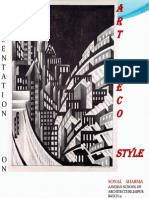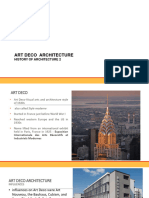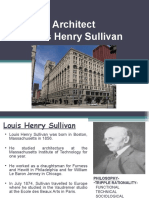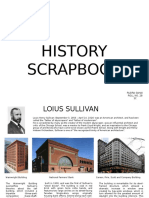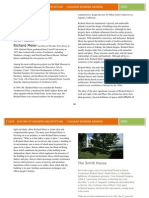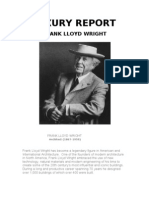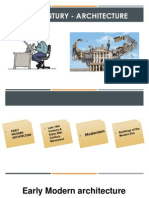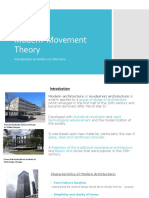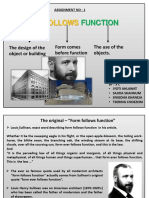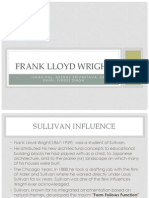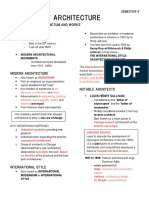Module Toa
Uploaded by
Renz RonquilloModule Toa
Uploaded by
Renz RonquilloAntoni Gaudi
“The straight line belongs to men, the curved one to god”
“There are no straight lines or sharp corners in nature. Therefore, buildings must have
no straight lines or sharp corners.”
• he is a Catalan architect in which his works are associated with Modernisme, and
Gaudi can be regarded as the most representative and outstanding or the Modernista
architects.”
• Gaudi’s buildings are characterized by their innovative designs and use or organic
forms. His architectural style was ahead of its time.
Art Deco
• 1920s in Europe, 1930 s in US
• Art Deco was a direct response aesthetically and philosophically to the Art Nouveau style and to the broader cultural
phenomenon of modernism,
• simple, clean shapes,
Notable Examples:
William Van Alen (August
Chrysler Building 10, 1883 – May 24, 1954)
William Van Alen was an American
Art Deco skyscraper on architect, best known as
the East Side of the architect in charge of
Manhattan in New York designing New York
City, at the intersection of City's Chrysler
42nd Street and Lexington Building (1928–30).
Avenue in Midtown
Manhattan.
Empire State Building
William Frederick
William F. Lamb
Lamb FAIA
102-story Art Deco skyscraper in
(November 21, 1883 –
Midtown Manhattan, New York City.
designed by Shreve, Lamb and Harmon in September 8, 1952),
the Art Deco style. The Empire State was an American
Building is 1,250 ft (381 m) tall to its architect, chiefly
102nd floor, or 1,453 feet 8 9⁄16 inches known as one of the
(443.092 m) including its 203-foot principal designers of
(61.9 m) pinnacle. It was the first building the Empire State
in the world to be more than 100 stories Building.
tall, though only the lowest 86 stories are
usable.
Fellow of the American Institute of Architects (FAIA) is a postnominal title or membership, designating an individual who has
been named a fellow of the American Institute of Architects (AIA).
Fellowship is bestowed by the institute on AIA-member architects who have made outstanding contributions to the profession
through design excellence, contributions in the field of architectural education, or to the advancement of the profession. In 2014,
fewer than 3,200 of the more than 80,000 AIA members were fellows. Honorary Fellowship (Hon. FAIA) is awarded to foreign
(non-U.S. citizen) architects, and to non-architects who have made substantial contributions to the field of architecture or to the
institute.
The construction of Chrysler Building and the Empire State Building was tagged as
skyscraper race. Empire state building tagged as characterless building; tallest skyscraper for
30 years until world trade center
GETTING TO KNOW THE MASTERS:
Louis Henry Sullivan
“form follows function”
• movements and styles: Art Nouveau, Organic Architecture, Modern Architecture
• father of skyscrapers, first American modern architect.
• Chicago is tagged as the birthplace of skyscrapers where Sullivan is the major player.
• Chicago Steel: these steel frame structures often featured terra cotta exteriors, plate glass windows, and detailed
cornices.
• He was Frank Lloyd Wright’s mentor
• he rejected classical elements and pioneered the use of steel- frame construction which allowed for the construction
of tall buildings with large windows and open floor plans, and to focus on organic ornamentation.
• Sullivanesque Style : his approach was to use the ornament and design to delineate a tall building into three distinct
parts - Entry, Mid and Top - and porthole windows at cornice level.
Notable Works:
Auditorium Building in Chicago
Henry Louis Sullivan
one of the best-known designs of Louis Sullivan and Dankmar Adler.
Completed in 1889, the building is located at the northwest corner of
South Michigan Avenue and Ida B. Wells Drive. The building was
designed to be a multi-use complex, including offices, a theater, and a
hotel. As a young apprentice, Frank Lloyd Wright worked on some of
the interior design.
Wainwright Building in St. Louis, Missouri
Henry Louis Sullivan
a 10-story, 41 m (135 ft) terra cotta office building at 709 Chestnut
Street in downtown St. Louis, Missouri. The Wainwright Building is
considered to be one of the first aesthetically fully expressed early
skyscrapers. It was designed by Dankmar Adler and Louis Sullivan
and built between 1890 and 1891. It was named for local brewer,
building contractor, and financier Ellis Wainwright.
Notable features are the spandrels and posts that both have
decorations.
Frank Lloyd Wright
“Every great architect is necessarily a great poet. He must be a great original interpreter
of his time, his day, his age.”
“I believe in God, only I spell it nature.” - Regarding organic architecture
“The greatest american architect of all time.”
• movements and styles: Art Deco, Organic Architecture, Modern Architecture, Prairie
Style
• over a 70 year career, he designed over 1000 structures of virtually every possible type
including a doghouse of which some 532 were built.
• Prairie Style: long, low, open plan structure that avoided the typical high, straight sided box in order to emphasize
the horizontal line of the prairie and domestically. Interior walls are minimized.
• Frank Lloyd Wright established the first truly American Architecture
• Usonian Style: simplified approach to residential construction that reflected both economic realities and changing
social trends.
• Organic Architecture: belief that human life is part of nature. Organically designed structures seem to melt with the
landscape or rise from it as if the surrounding spaces give birth to them.
Notable Works:
Winslow House in Illinois, Chicago
Frank Lloyd Wright
A landmark building in Wright's career, the Winslow House, built in
1893–94, was his first major commission as an independent architect.
While the design owes a debt to the earlier James Charnley House, Wright
always considered the Winslow House extremely important to his career.
Looking back on it in 1936, he described it as "the first 'prairie house’.”
Taliesin West in Scottsdale, Arizona
Frank Lloyd Wright
was Frank Lloyd Wright's winter home and studio in the desert from 1937
until his death in 1959 at the age of 91. Today, it is the headquarters of the
Frank Lloyd Wright Foundation. It is the only UNESCO World Heritage
site open to the public in the state of Wisconsin and it is also a National
Historic Landmark)
Fallingwater in Mill Run, Pennsylvania
Frank Lloyd Wright
built partly over a waterfall on Bear Run in the Mill Run section of
Stewart Township, Pennsylvania. The house was designed to serve as a
weekend retreat for Liliane and Edgar J. Kaufmann, the owner of
Pittsburgh's Kaufmann's Department Store. Most notable feature is the
7-meter long cantilevered terrace.
According to Franklin Toker, Fallingwater’s most important contribution
to Modern Architecture is surely the "acceptance of Modern
architecture itself."
Hugo Alvar Henrik Aalto
“Architecture belongs to culture not to civilization”
“Architecture cannot save the world, but it may serve as a good example.”
• one of Finland’s most celebrated Architect. Sometimes called the “father of
modernism” in the Scandinavian countries.
• Movements and Styles: from Classicism to Functionalism to Monumentalism
• He was part of the modern movement of architecture but he developed his own style,
notable use of wood elements inspired by the Finnish forests and evoking a pre-industrial
spirit and sense of freedom.
Paimio Sanatorium in Paimio, Finland
Alvar Aalto
A former tuberculosis sanatorium. Aalto received the design commission
having won the architectural competition for the project held in 1929. The
building was completed in 1933, and soon after received critical acclaim both
in Finland and abroad. The sanatorium has been nominated to become a
UNESCO World Heritage Site.
Finlandia Hall in Helsinki, Finland
Alvar Aalto
completed in 1971. Every detail in the building is designed by Aalto. The
designs were completed in 1962, with building taking place between 1967 and
1971. A lattice ceiling hides the space to the audience but it allows the creation
of the same deep post-echo as tall church towers. Aalto used Italian Carrara
marble in both indoor and outdoor surfaces as a contrast to black granite. For
Aalto, the marble was a tie to the Mediterranean culture, which he wanted to
bring to Finland.
MIT Baker House in Cambridge, Massachusetts
Alvar Aalto
Its distinctive design has an undulating shape which allows most rooms a
view of the Charles River, and the dining hall features a "moon garden"
roof. Aalto also designed custom furniture for the building's rooms, many
of which are wedge-shaped. Baker House was renovated for its fiftieth
anniversary in 1999, modernizing the plumbing, telecommunications, and
electrical systems and removing some of the interior changes made over
the years that were not in Aalto's original design.
International Style
• The architecture of the modern movement 1910 to 1970
• Became the global symbol of modernity.
• The term international style was coined by Henry-Russell Hitchcock and Philip Johnson.
• Definitive architectural language of north American post-war modernism and influenced hundreds of emulators
worldwide.
• It is often described as minimalist due to the tendency of its adherents to design buildings that were devoid of all
ornament and reduced to their most basic structural elements
• Use of steel concrete and glass
• Notable Architects: Walter Gropius, Mies van der Rohe, Le Corbusier, Peter Behrens (factory designs)
Walter Gropius
“We want to create the purely organic building, boldly emanating its inner laws, free of
untruths or ornamentation.”
“Architecture begins where engineering ends. “
• one of the pioneers of modern architecture, he was the founder of Bauhaus, a
revolutionary art school in Germany. Bauhaus in German literally means “construction
house.”
• movement and styles: Bauhaus, the international style, functionalism
Bauhaus was an influential art and design movement that began in 1919 in Weimar, Germany. Its goal was to merge
all artistic mediums into one unified approach, that of combining an individual’s artistry with mass production and
function. Notable features are geometric, abstract, style featured, non-load bearing façade.
Bauhaus Building in Weimar, Germany
Walter Gropius
The building was constructed between 1925 and 1926 according to plans by Walter
Gropius as a school building for the Bauhaus School of Art, Design and Architecture.
It was only functional for 1 year because he refused to use the school for a
base for German Nazi soldiers.
Fagus Factory in Alfeld, Germany
Walter Gropius and Adolf Meyer
The building that had the greatest influence on the Fagus factory design was
the 1909 AEG turbine factory in Berlin, designed by Peter Behrens.
Notable features are corners free of supports, and glass surfaces between
piers that cover the whole height of the building, the corners are left open
and the piers are recessed leaving the glass surface to the front.
Le Corbusier (Charles-Édouard Jeanneret)
“Architecture is the masterly, correct and magnificent play of volumes brought together in light”
“A house is a machine for living in.”
• Movements and styles: International style, purism, brutalism
• One of the most influential urban planner and architect of the 20th century. One of the
key designers who formulated the ideas behind a truly modern, avant-garde architecture
during the interwar period.
• Proponent of purism in 1918. Purism is the simplification and modulation of form while
rejecting the society’s bourgeois notion of beauty at the time.
• Conceived the five points of architecture: Piloti, Ribbon Window, Free-plan, Free-
façade, Roof Garden
Notable Works:
Palace of Assembly in Chandigarh, India
Le Corbusier
It features a circular assembly chamber, a forum for conversation and
transactions, and stair-free circulation. The building was designated as a
UNESCO World Heritage Site in 2016.
Unite d’Habitation
Le Corbusier
Often described as “city within a city” is a modernist residential housing
typology developed by Le Corbusier, with the collaboration of painter-architect
Nadir Afonso. It was added to the UNESCO World Heritage List in 2016
because of its importance to the development of modernist architecture.
Villa Savoye in Poissy, France
Le Corbusier
As an exemplar of Le Corbusier's "five points" for new constructions, the villa is
representative of the origins of modern architecture and is one of the most easily
recognizable and renowned examples of the International style. It continues to be
considered as one of the most significant contributions to modern architecture in
the 20th century.
Related Work:
E-1027 in Roquebrune-Cap-Martin, France
Eileen Grey and Jean Badovici
L-shaped and flat-roofed with floor-to-ceiling windows and a spiral stairway to
the guest room, E-1027 was both open and compact.
The Swiss born-French Modernist architect Le Corbusier was a friend of
Badovici and visited the house several times after Badovici and Gray had parted.
While staying as a guest in the house in 1938 and 1939, Le Corbusier painted bright murals on its plain white walls, and
sometimes painted in the nude.
Ludwig Mies Van der Rohe
“God is in the details”
“Architecture is the will of an epoch translated into space.”
“Less is more”
• Movements and styles: Minimalism, International Style, Chicago School II
• He first called his designs for steel-and-glass skyscrapers and horizontally-oriented
houses and pavilions “skin-and-bones” architecture due to their minimal uses of industrial
materials, definition of space, along with the rigidity of structure and their transparency.
Notable Works:
S.R. Crown Hall in Chicago, Illinois
Ludwig Mies van der Rohe
the home of the College of Architecture at the Illinois Institute of
Technology and is considered architecturally significant because he
refined the basic steel and glass construction style, beautifully
capturing simplicity and openness for endless new uses. Creating this
openness was achieved by the building having a suspended roof,
without the need for interior columns. Mies van der Rohe considers this building to be the embodiment of his famous
statement “less is more.”
Farnsworth House in Plano, Illinois
Ludwig Mies van der Rohe
The house was constructed as a one-room
weekend retreat in a rural setting and is widely
recognized as an exemplar of International
Style of architecture.
Seagram Building in New York
Ludwig Mies van der Rohe and Philip Johnson
It was the first office building in the world to use extruded bronze on a facade, as well
as the first New York City skyscraper with full-height plate glass windows.
Kenzo Tange
"Architecture must have something that appeals to the human heart, but even then, basic forms, spaces and
appearances must be logical. Creative work is expressed in our time as a union of technology and humanity.”
• Movements and Styles: Combining traditional Japanese styles with Modernism, Brutalism
• one of japan’s most honored architects. Teacher, writer, architect, and urban planner. He
heavily influenced four young architects who founded Metabolism Movement (Kiyonori
Kikutake, Kisho Kurokawa, Fumihiko Maki and critic Noboru Kawazoe
• after world war two he worked as an urban planner, helping to rebuild Hiroshima and
gained international attention in 1949.
• 1960 Master plan for Tokyo
Notable Works:
St. Mary’s Cathedral in Tokyo, Japan
Kenzo Tange
The layout of the building is in the form of a cross, from which eight
hyperbolic parabolas open upwards to form a cross of light, which continues
vertically along the length of the four facades. This Tange design inspired the
later similar design of the landmark cathedral in San Francisco, also referred
to as St. Mary's Cathedral.
Hiroshima Peace Memorial Park
Kenzo Tange
The location of Hiroshima Peace Memorial Park was once the city’s busiest
downtown commercial and residential district. The park was built on an open
field that was created by the explosion.
Richard Neutra
“I try to make a house like a flower pot, in which you can root something and out of
which family life will bloom.”
“Architects must have a razor-sharp sense of individuality.”
• Movements and Styles: Modernism, international style and Biorealism
• Biorealism: the inherent and inseparable relationship between man and nature
• known for his role in introducing the international style into American architecture.
Notable Works:
Kaufman House in Parlm Spring, California
Richard Neutra
The house has been described as "an architectural marvel that helped define the
modernist aesthetic of the resort city of Palm Springs.” It is designated a Class 1
Historic Site by Palm Springs City Council.
Considered as Neutra’s masterpiece and a fine example of International Style
Tower of Hope – Christ Cathedral
Richard Neutra
13-story tower with the elevator and stairwell mounted on the exterior of the
building, freeing up nearly 1,650 sf of usable space on each floor out of a
footprint of 1,850 sf.
Oscar Neimeyer “the king of curves”
• He was one of the greatest architects in Brazil’s history, and one of the greats of
the global modernist movement.
• Known for using white concrete, graceful curves, and primary-color accents.
Notable Works: Cathedral of Brasilia
Oscar Neimeyer
Niemeyer’s intention was to create a volume that has the same ‘purity’ from
any perspective. The cathedral is a hyperbolic structure built from concrete. It
measures 40 m in height and is capable of holding up to 4,000 people. The base
is circular and measures around 60 m in diameter. The structure, with its glass
ceiling, is supported by 16 curved steel columns which weigh 90 tonnes each.
The large stained-glass windows are shaped into triangles that fit together
between the columns.
Palacio de Planalto
Oscar Neimeyer
constructed in the modernist style, is part of the Brasília World
Heritage Site, designated by UNESCO in 1987.
National Congress of Brazil
Oscar Neimeyer
The semi-sphere on the left is the seat of the Senate, and the semi-sphere
on the right is the seat of the Chamber of the Deputies. Between them
are two vertical office towers. The Congress also occupies other
surrounding office buildings, some of them interconnected by a tunnel.
Niterói Contemporary Art Museum
Oscar Neimeyer
Designed by Oscar Niemeyer with the assistance of structural engineer Bruno
Contarini. The structure is 16 meters high; its cupola has a diameter of 50
meters with three floors. The saucer-shaped modernist structure, which has
been likened to a UFO, is set on a cliffside, at the bottom of which is a beach.
Louis Khan
“An architect can build a house and build a city in the same breath, if he thinks about it as being a marvelous,
inspired, expressive realm.”
• Movements and Styles: International style and classical-modernism
• an American architect known for combining modernism with the weight and dignity of ancient monuments.
Notable Works:
First Unitarian Church of Rochester, New York
Louis Kahn
The building was described in 1982 as one of "the most significant works of
religious architecture of this century" by Paul Goldberger, a Pulitzer-Prize-
winning architectural critic. Its exterior is characterized by deeply folded
brick walls created by a series of thin, two-story light hoods that shield
windows from direct sunlight.
Kimbell Art Museum in the US
Louis Kahn
widely recognized as one of the most significant works of architecture of
recent times. It is especially noted for the wash of silvery natural light
across its vaulted gallery ceilings. It is also the usual venue for the Pritzker
Award Ceremony.
Jatiya Sangsad Bahban in Bangladesh
Louis Kahn
one of the largest legislative complexes in the world, covering 200 acres
(810,000 m2). The exterior of the building is striking in its simplicity, with
huge walls deeply recessed by porticoes and large openings of regular
geometric shapes. This skillful use of water to portray the riverine beauty
of Bengal adds to the aesthetic value of the site.
Salk Institute in San Diego, California
Louis Kahn
composed of three clusters: meeting and conference areas, living
quarters, and laboratories. Only the laboratory cluster, consisting of two
parallel blocks enclosing a water garden, was built. The two laboratory
blocks frame a long view of the Pacific Ocean, accentuated by a thin
linear fountain that seems to reach for the horizon.
I.M. Pei (Ieoh Ming Pei)
“A lasting architecture has to have roots.”
• Chinese-American architect who went on to create dramatic buildings known for their
angular geometry, expansive glass and concrete walls, spacious indoor atriums, and
space-frame skylights.
• He has given this century some of its most beautiful interior spaces and exterior forms.
• His signature can be compared to the music of Bach. Constant variation of a simple
theme.
Notable Works:
Louvre Museum in Paris, France
I.M. Pei
rectangular in shape. It is complex in that it includes a square structure
with 2 extending wings, forming an overall shape resembling a rectangle.
Exterior elements of the Louvre include I.M. Pei's Grand Louvre Pyramid,
located in the middle of the central courtyard.
Bank of China Tower in Hong Kong
I.M. Pei
Distinctive three-dimensional triangular shape (quadrilateral at the
bottom and trilateral at the top), which, according to Pei, transfers “all
vertical stress to the four corners of the building, making it very stable
and wind resistant”
Rock and Roll Hall of Fame in Cleveland, Ohio
I.M. Pei
One side is joined by a glass structure with four triangular sides, called
a tetrahedral design. The site is 4 acres, while the building is 143,000
square feet.
Eero Saarinen
“Function influence but does not dictate form.”
“The purpose of architecture is to shelter and enhance man’s life on earth and to fulfill in
the nobility of his existence.”
• Movements and Styles: International style, Neo-futuristic
• A Finnish-American architect known for his dynamic and fluid forms
• Often called a “second generation” modernist for the way he moved beyond the rigid
glass box aesthetic.
• He enjoyed the concept of exposing the structure of the building with steel.
Notable Works:
Dulles International Airport in Virginia U.S.
Eero Saarinen
the terminal building features columns on its two long
facades, with a curving roof connect them. Architect Eero
Saarinen reportedly called it "the best thing I have ever
done." It was the first commercial airport designed
specifically for jet air travel
TWA Flight Center in New York City
Eero Saarinen
pioneering example of thin-shell construction, consisting of a reinforced
concrete shell roof supported at the corners. The design incorporates
elements of the Futurist, Neo-futurist, Googie and Fantastic architectural
styles.
The Gateway Arch in Missouri, USA
Eero Saarinen
The strong, elegant shape of the arch represents a door to the western part of the
country. The arch is 630 feet (192 metres) tall, and the distance between its two legs is
equal to its height.
Frei Otto
“To build means to make architecture real on the borders of knowledge.”
“I have built little. But, I have built many castles in the air.”
• a German architect and structural engineer noted for his use of lightweight structures
• Introduced tensile fabric or tensile roofing as he was attracted to them partly for their economical and ecological
values.
Notable Works:
Expo 67 German Pavilion in Montreal, Canada
Frei Otto
demonstrated the increasing importance of technology, pre-fabrication and mass
production in architecture and brought worldwide attention to his innovations in
tensile structures for the first time.
Munich Olympiastadion in Munich, Germany
Frei Otto
a tensile membrane structure that covered the entire stadium and
measured over 74,000 square meters. The translucent fabric
membranes that made up the tensile membrane ceiling of the
Munich Olympic Stadium were supported by an intricate system of
steel cables and poles.
Buckminster Fuller
“You never change things by fighting the existing reality. To change something, build
a new model that makes the existing model obsolete.”
• an American architect, systems theorist, writer, designer, inventor, philosopher, and
futurist.
• He was partially blind and is known for his advanced ideas.
Notable Works:
Biosphere Environment Museum in Monteal, Canado
Buckminster Fuller
Architectural masterpiece and symbol of Expo 67 which features a
spectacular geodesic dome that was once clad in an acrylic skin that was
shaded to control the internal temperature.
Wichita House (Dymaxion House)
Buckminster Fuller
Designed to address several perceived shortcomings with existing homebuilding
techniques. A key design consideration was ease of shipment and assembly. Fuller
combined the words dynamic, maximum, and tension to arrive at the term
Dymaxion.
The Wichita House was a prototype house that would have been used to house U.S.
military personnel returning from World War II.
BRUTALISM
• Béton brut or crude concrete 1950s to 1970s
• the construction of his own rough, concrete buildings.
• Architecture in the raw, with an emphasis on materials, textures and construction,
producing highly expressive forms. Seen in the work of Le Corbusier from the late
1940s with the Unite d’Habitation in Marseilles, the term Brutalism was first used
in England by the architectural historian Reyner Banham in 1954.It referred to the
work of Alison and Peter Smithson’s school at Hunstanton in Norfolk because of its
uncompromising approach to the display of structure and services, albeit in a steel Figure 1 Unite d' Habitation by Le
building rather than reinforced concrete. Corbusier
Marcel Breuer
• was a Hungarian-German modernist architect and furniture designer.
• At the Bauhaus he designed the Wassily Chair and the Cesca Chair, which The New
York Times have called some of the most important chairs of the 20th century.
• One of the most-influential exponents of the International Style; he was concerned with
applying new forms and uses to newly developed technology and materials in order to
create an art expressive of an industrial age.
Notable Works:
The MET Breuer
Marcel Breuer, Hamilton P. Smith, Richard Gluckman & Michael Irving
Materials include terrazzo, board-formed and bush-hammered concrete,
bluestone floors, walnut parquet, and the famous gray granite of the
façade, which Ada Louise Huxtable described by as "one of the
handsomest stones to be seen in New York."
St. John’s Abbey Church
Marcel Breuer
features cast-in-place concrete which became a stepping-stone in the
modern design of religious architecture in the United States. The
structure consists of giant, trunk-like stems that support the ceiling and a
dominant bell banner that shields the church.
IBM Research Center (IBM La Gaude)
Marcel Breuer
building has a distinctive double Y-shaped plan set across a sloping
site, mediated by raising the two levels on to “pilotis” or stilts.
Constructed using an in-situ concrete system with columns along the
exterior, these are hidden by precast concrete units along the facade.
This allowed for a column-free internal space, creating total flexibility
and so that light can penetrate throughout the building. The concrete
exterior was left rough so that the colour could blend with the
surrounding landscape
Tadao Ando
Japanese autodidact architect whose approach to architecture and landscape was categorized by architectural
historian Francesco Dal Co as "critical regionalism".
winner of the 1995 Pritzker Prize.
architectural style is said to create a "haiku" effect, emphasizing nothingness and empty space to represent the
beauty of simplicity.
Notable Works:
Church of the Light (Ibaraki Kasugaoka Church)
Tadao Ando
embraces Ando’s philosophical framework between nature and architecture through
the way in which light can define and create new spatial perceptions equally, if not
more so, as that of his concrete structures. For Ando, the Church is an architecture
of duality – the dual nature of existence – solid/void, light/dark, stark/serene. the
concrete structure removes any distinction of traditional Christian motifs and
aesthetic.
Suntory Museum
Tadao Ando
The museum is going to meet the sea with a 100 square meters and a depth of 40
m, consisting of stairs and slopes to enter everyday life in the water. The
composition of the building consists of an inverted truncated cone intersecado
two volumes binoculars, gallery and restaurant. The cone is 48 m in diameter
acristala to see the ocean and left the area inside the theater, as if it were a giant
Post Modernism (unornamented)
A counter to the utopian ideals of modernism and involved reinterpreting historic forms
is an eclectic, colorful style of architecture and the decorative arts that appeared from the 1970s. As a reaction
against the austerity, formality, and lack of variety of modern architecture, particularly in the international style.
Robert Venturi and Denise Scott-Brown
“Less is a bore”
“More is more”
Author of acclaimed book “complexity and contradiction
in architecture”
Venturi led the development of post-modernism movement
in architecture during the 1970s.
Architecture that promotes richn ess and ambiguity over
unity and clarity, contradiction and redundancy over
harmony and simplicity.
Movements and style: post modernism
Notable Works:
Fire Station No. 4 (Billboard Architecture)
Robert Venturi & Denise Scott-Brown
features a trapezoidal plan, with a semicircular tower serving as the main
entrance to the building. Notable about this tower is the large yellow number
4 which has been placed on top.
Children Museum Houston
Robert Venturi & Denise Scott-Brown in association with Jackson and Ryan
Architects
designed the space to evoke both institutional monumentality "typical of the
adult world" as well as playfulness befitting an institution primarily serving
children.
Vanna Venturi House
Robert Venturi & John Rauch
The five-room house stands only about 30 feet (9 m) tall, but has a monumental
front façade. Elements such as a non-structural applique arch and "hole in the
wall" windows were an open challenge to Modernist orthodoxy, as described in
Venturi's 1966 book Complexity and Contradiction in Architecture .
Philip Johnson
“Architecture is the art of how to waste space.”
First ever Pritzker architecture prize in 1979
He curated the controversial 1932 show “modern architecture: international exhibition,” which introduced
America to European modernism.
Movements and Styles: Modernism and Post-
modernism
AT&T Building
Philip Johnson & John Burgee
A large entrance arch at the base of the building faces east toward Madison Avenue,
flanked by arcades with smaller flat arches. Regarded as the first post-modern skyscraper,
“chippendale” roof line.
Glass House
21st Century Architecture
High tech 1970s
Type of late modern style also known as Structural Expressionism
High tech buildings are often called machine-like. Steel, aluminum, and glass combine with brightly colored
braces, girders, and beams
Sir Norman Foster “the hero of high-tech”
“Architecture is an expression of values”
“As an architect, you design for the present, with an awareness of the past, for a future
which is essentially unknown.”
He is known for sleek, modern designs of steel and glass with innovations in
contouring and inner space management.
Revolutionized skyscraper design by using steel tube frames and exposing structural,
technical, and functional components.
Hearst Tower
Norman Foster
The exterior of Hearst Tower boasts an innovative glass and steel diagrid design,
which makes for a modern look that is unlike any other skyscraper in North America,
and from top to bottom the Tower has an emphasis on modern technology and
sustainable design. In 2012 became the first building to receive both Gold and
Platinum LEED certifications.
London City Hall
Norman Foster
its glass enclosure allowing Londoners to watch the Assembly at work. Members of
the public are also invited to share the building: a flexible space on the top floor –
‘London’s Living Room’ - can be used for exhibitions or functions, and the public
commands the rooftop, where a terrace offers unparalleled views across London.
Lifts and gentle ramps allow universal access throughout the building.
HSBC Building, Hong Kong
Norman Foster
The building is a steel suspended structure and was finished on 18 November
1985. Its design and construction included the installation of the "Asian Story
Wall", a multimedia installation consisting of twin banks of 30 seamless
plasma screens (the largest installation of its kind in Hong Kong) displaying
archived bank heritage and artworks.
Apple Park (Apple Campus 2)
Norman Foster
The main building's scale and circular groundscraper design have earned
the structure the media nickname "the spaceship". 80 percent of the site
consists of green space planted with drought-resistant trees and plants
indigenous to the Cupertino area, and the center courtyard of the main
building features an artificial pond. Considered as one of the most
energy efficient buildings on earth
Richard Rogers
Architecture is “a place for all people”
All good architecture is modern in its time.
Was a British-Italian architect noted for his modernist and constructivist designs in high-tech architecture.
His technique is known as “Bowellism”
Centre Pompidou
Richard Rogers, Su Rogers, Renzo Piano & Gianfranco
Franchini
It was the first major example of an 'inside-out' building
with its structural system, mechanical systems, and
circulation exposed on the exterior of the building.
According to Piano, the design was meant to be "not a
building but a town where you find everything – lunch,
great art, a library, great music".
Renzo Piano
Lloyd’s Building
Richard Rogers
distinguished by its radical inside-out aesthetic that sees all
its building services banished to its exterior in order to
create uninterrupted spaces inside.
Architecture is
art, but art
vastly contaminated by many other things. Contaminated in the best
sense of the word-fed, fertilized by many things”
Movements and Styles: Bold Post-modernism and High-Tech
Figure 2 The New York Times
Deconstructivism (1980s - present) Building
Characterized by ideas of fragmentation. The basic elements of
architecture are dismantled and many seem no visual logic.
Peter Eisenman
“best architecture was incongruous and disharmonious”
Peter David Eisenman is an American architect, writer, and professor. Considered
one of the New York Five, Eisenman is known for his high modernist and
deconstructive designs, as well as for his authorship of several architectural books.
His work has won him several awards, including the Wolf Prize in Arts.
Wexner Center for the City of Culture of Galicia
Visual Arts and Fine the design of the buildings
Jewish Arts
Museum Berlin
Library Royal Ontario
involves high degree Museum
contours,
A Void cuts
Basedthrough
on thethe meant to (ROM)
make the buildings
zigzagging plan of
controversial the new
theory that structure is rolling
look like heavilyhills.
massed and
Nearly
building and creates be
art should a space punctuated
every window byofrounded and
the thousands
that embodies absence.
"challenged" It is
by its segmented arched
that are part of thewindows
external
aenvironment
straight line rather
whosethan with
façade heavy surrounds
has its own customand hood
shape.
impenetrability
displayedbecomes
neutrallythe mouldings. Other features
central focus around which include applied decorative eave
exhibitions are organized. brackets, quoins and cornices.
Daniel Libeskind
Frank Gehry
“Architecture should speak of its time and place, but yearn for timelessness.”
All Gehry’s designs are united by their sense of movement, he embeds motion
directly into his architecture.
His original, sculptural, often audacious work won him worldwide renown.
Primarily use corrugated metals which give his look an unfinished appearance.
arguably the most important architect of the contemporary era and certainly the most
famous living architect.
Movements and Styles: Post-modernism and deconstructivism
Notable Works:
Fondation Louis Vuitton
The resulting glass building takes the form of a sailboat's sails inflated
by the wind. These glass sails envelop the "iceberg", a series of shapes
with white, flowery terraces. The galleries on the upper floors are lit by
recessed or partially hidden skylights.
Guggenheim Bilbao
it is clad in titanium plates, arranged in scales, on a galvanized steel
structure. The museum's exterior skin is made of 33,000[22] titanium
plates, a material that has been used to replace copper or lead
because of their toxicity
8 Spruce Street / New York by Gehry
standout feature of the design is the wavy stainless steel facade that
curves along three sides of the building (there south side is flat).
Comprising approximately 10,500 custom-made stainless steel
panels from Japan, the facade resembles a puzzle when assembled.
Walt Disney Concert Hall
one of the most acoustically sophisticated concert halls in the
world and provides both visual and aural intimacy through its
exterior and interior design.
Rem Koolhas
“Kill the skyscraper”
“The skyscraper has become less interesting in inverse proportion to its success. It has
not been refined. But corrupted.”
He has revolutionized the way architects look at program and interaction of space.
“One of architecture’s most influential thinkers.”
Known for his striking often gravity-defying structures
Movements and Styles: Deconstructivism, abstractionism and post-modern metabolism
Notable Works:
CCTV Headquarters
75.00m cantilever. It was an attempt to present an alternative format for high-rise
buildings that reinforced a sense of community rather than separating people into
individual tower blocks.
IIT McCormick Tribune Campus Center
The large single-storey Campus Center provides a focal point for the
previously sundered halves of the campus, and features a noise-absorbing
steel tube wrapping the Elevated metro that runs directly over the building
and, inside, a dense mosaic of programs including a bookstore, food court,
café, auditorium, computer centre, and meeting spaces.
Zaha Hadid “Queen of the curve”
Famous for her intensely futuristic architecture characterized by curving facades, sharp angles, and severe
materials such as concrete and steel.
First female Pritzker prize winner in 2004
First woman to receive the Pritzker architecture prize, the Stirling prize and Riba gold medal
Movements and Styles: Deconstructivism and Parametricism
Al Wakrah Stadium
it was inspired by the sails of traditional Dhow boats, used by pearl divers
from the region, weaving through currents of the Persian Gulf. The curvilinear
roof and exterior references Al Wakrah's history of seafaring, additionally
giving spectators the feeling on being on a ship.
Leeza SOHO or Li Ze Tower Beijing
The Leeza SOHO features a 194 m (636 ft) tall twisting atrium at its centre,
which is the tallest in the world, a title previously held by the Burj Al Arab
hotel in Dubai. The atrium twists 45° over the height of the building to
allow natural light to all floors. Structural rings at each level, four sky
bridges, and a double-insulated glass façade unite the two halves of the
tower together.
You might also like
- Modern and Post Modern Architecture 202, 215, 216100% (1)Modern and Post Modern Architecture 202, 215, 21664 pages
- Louis Sullivan: "Form Follows Function"No ratings yetLouis Sullivan: "Form Follows Function"13 pages
- Louis Henry Sullivan: Prepared and Presented byNo ratings yetLouis Henry Sullivan: Prepared and Presented by68 pages
- Empire State Building: Shreve, Lamb & HarmonNo ratings yetEmpire State Building: Shreve, Lamb & Harmon7 pages
- 4 KC7 M PVMJ 5 KPKeorq 0 Qyeo Eoy L9 P GYGyh SK INIB3 A QED6 Rahy Zu 8 X QSB 9 XSV QX GGNo ratings yet4 KC7 M PVMJ 5 KPKeorq 0 Qyeo Eoy L9 P GYGyh SK INIB3 A QED6 Rahy Zu 8 X QSB 9 XSV QX GG75 pages
- Compilation of Famous Architects and Their Architectures: Submitted By: Regine G. ChiongNo ratings yetCompilation of Famous Architects and Their Architectures: Submitted By: Regine G. Chiong13 pages
- Philip Johnson Who Lived in A Glass HouseNo ratings yetPhilip Johnson Who Lived in A Glass House48 pages
- Arts ND Crafts Movement-Chicago-Reliance-Art NoveuNo ratings yetArts ND Crafts Movement-Chicago-Reliance-Art Noveu45 pages
- History of Architecture (Industrial Revolution To Post Modern)No ratings yetHistory of Architecture (Industrial Revolution To Post Modern)32 pages
- HH Arnason - Early 20th Century Architecture (Ch. 12)No ratings yetHH Arnason - Early 20th Century Architecture (Ch. 12)18 pages
- Chicago School Frank Lloyd Wright Prairie School: Sullivan and The Steel High-RiseNo ratings yetChicago School Frank Lloyd Wright Prairie School: Sullivan and The Steel High-Rise4 pages
- 06_1_Wright, Frank Lloyd. the Natural HouseNo ratings yet06_1_Wright, Frank Lloyd. the Natural House215 pages
- HH Arnason - The Origins of Modern Architecture and Design (Ch. 04)No ratings yetHH Arnason - The Origins of Modern Architecture and Design (Ch. 04)10 pages
- Contemporary Architecture Question and Answer: Bauhaus and Chicago SchoolNo ratings yetContemporary Architecture Question and Answer: Bauhaus and Chicago School10 pages
- Louis Sullivan (Tod) Kritika Panwar 8TH Sem 20-04-20No ratings yetLouis Sullivan (Tod) Kritika Panwar 8TH Sem 20-04-207 pages
- Louis H Sullivan and A 19th Century Poetics of Naturalized Architecture IntroNo ratings yetLouis H Sullivan and A 19th Century Poetics of Naturalized Architecture Intro15 pages
- Full download (Ebook) Air-Conditioning in Modern American Architecture, 1890–1970 by Joseph M. Siry ISBN 9780271086941, 0271086947 pdf docx100% (6)Full download (Ebook) Air-Conditioning in Modern American Architecture, 1890–1970 by Joseph M. Siry ISBN 9780271086941, 0271086947 pdf docx81 pages
- Architecture in Colonial and Post Colonial America80% (10)Architecture in Colonial and Post Colonial America55 pages
- Master Architect (Louis Henry Sullivan)No ratings yetMaster Architect (Louis Henry Sullivan)23 pages
- INT211 10 Arts & Crafts and Art Nouveau PDFNo ratings yetINT211 10 Arts & Crafts and Art Nouveau PDF45 pages
- Kantipur International College: Department of Architecture Gwarko, LalitpurNo ratings yetKantipur International College: Department of Architecture Gwarko, Lalitpur35 pages
- 4 KC7 M PVMJ 5 KPKeorq 0 Qyeo Eoy L9 P GYGyh SK INIB3 A QED6 Rahy Zu 8 X QSB 9 XSV QX GG4 KC7 M PVMJ 5 KPKeorq 0 Qyeo Eoy L9 P GYGyh SK INIB3 A QED6 Rahy Zu 8 X QSB 9 XSV QX GG
- Compilation of Famous Architects and Their Architectures: Submitted By: Regine G. ChiongCompilation of Famous Architects and Their Architectures: Submitted By: Regine G. Chiong
- Arts ND Crafts Movement-Chicago-Reliance-Art NoveuArts ND Crafts Movement-Chicago-Reliance-Art Noveu
- History of Architecture (Industrial Revolution To Post Modern)History of Architecture (Industrial Revolution To Post Modern)
- HH Arnason - Early 20th Century Architecture (Ch. 12)HH Arnason - Early 20th Century Architecture (Ch. 12)
- Chicago School Frank Lloyd Wright Prairie School: Sullivan and The Steel High-RiseChicago School Frank Lloyd Wright Prairie School: Sullivan and The Steel High-Rise
- HH Arnason - The Origins of Modern Architecture and Design (Ch. 04)HH Arnason - The Origins of Modern Architecture and Design (Ch. 04)
- Contemporary Architecture Question and Answer: Bauhaus and Chicago SchoolContemporary Architecture Question and Answer: Bauhaus and Chicago School
- Louis Sullivan (Tod) Kritika Panwar 8TH Sem 20-04-20Louis Sullivan (Tod) Kritika Panwar 8TH Sem 20-04-20
- Louis H Sullivan and A 19th Century Poetics of Naturalized Architecture IntroLouis H Sullivan and A 19th Century Poetics of Naturalized Architecture Intro
- Full download (Ebook) Air-Conditioning in Modern American Architecture, 1890–1970 by Joseph M. Siry ISBN 9780271086941, 0271086947 pdf docxFull download (Ebook) Air-Conditioning in Modern American Architecture, 1890–1970 by Joseph M. Siry ISBN 9780271086941, 0271086947 pdf docx
- Architecture in Colonial and Post Colonial AmericaArchitecture in Colonial and Post Colonial America
- Kantipur International College: Department of Architecture Gwarko, LalitpurKantipur International College: Department of Architecture Gwarko, Lalitpur
















